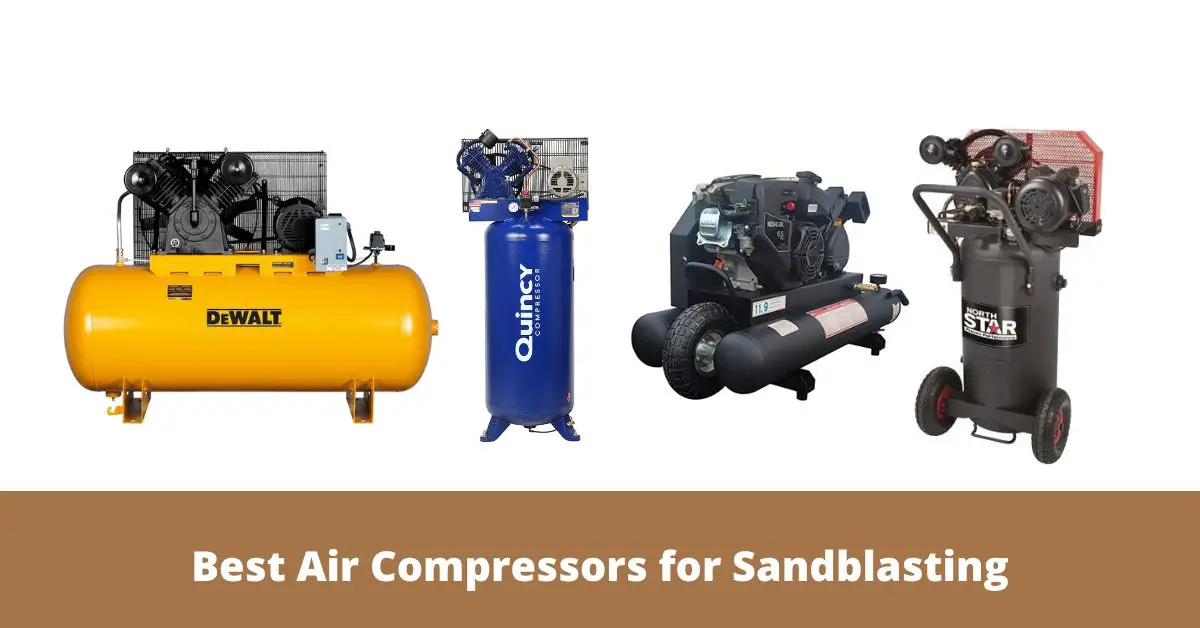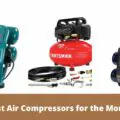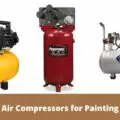Air Compressors
Best Air Compressors for Sandblasting
Best Air Compressors for Sandblasting
One of the main reasons I bought my first air compressor was for sandblasting. Sandblasting, also known as abrasive blasting, uses compressed air filled with abrasive materials (sand) to remove various stains and coatings.
It effectively removes typical stains such as rust and paint but can also clear grease stains and scales caused by heat treatment. Pressurized air cleans quickly, smoothly, and evenly on any surface, which makes it ideal for a wide range of projects.
Although this is predominantly a job for air compressors, not all of them are designed for this specific task. Air pressure, air volume, and nozzle size largely determine which air compressors do better than others.
Also, different types of stains call for different types of air compressors. For example, when working on a large sheet of rusted metal, I would prioritize air volume and nozzle size over air pressure because rust comes off with fairly low pressure.
Before buying any compressor for sandblasting, I recommend going through the following buying guide.
What Makes Air Compressors Good at Sandblasting?
Air volume (CFM)
Air volume, measured in Cubic Feet per Minute (CFM), tells you how much air a compress can blast out in a minute.
This is important because the more air released, the higher the abrasive force of the air compressor. Therefore, dealing with tougher stains and coats requires you to find air compressors with high CFM ratings.
There’s only one downside to owning a high CFM compressor: it can run out of air pretty fast. I’m always wary of the tank size when it comes to air compressors with high CFM ratings.
Air pressure (PSI)
Air pressure mostly indicates the speed at which abrasives are hurled out of the compressor. As you may have guessed, a higher PSI results in more abrasive power, which is also an important metric.
Of course, the importance of PSI will depend on the type of job you’re undertaking. If you’re dealing with a slightly less stubborn stain, then air pressure ceases to be as important as air volume.
Nozzle size
The size of the nozzle is very important when it comes to sandblasting. For small jobs, the best size is a #2 nozzle. Large jobs normally utilize a #4 nozzle, while heavy-duty jobs require no less than a #6 nozzle.
These nozzles measure 1/8 of an inch, ¼ of an inch, and ½ an inch in diameter, respectively.
Nozzles are prone to wearing down and growing larger with use, and with a larger diameter, you need much more CFM to accomplish the task.
Tank size
The size of a compressor’s tank can be a limiting factor, so it’s important to get a tank that’s large enough to handle your workload.
Like spray painting, you need a continuous air supply when sandblasting. Otherwise, you’ll find yourself caught in the tedious cycle of stopping to refill every few hours.
Air Compressor Specifications for Different Jobs
Small Jobs
For small sandblasting jobs, the combination I find most effective looks like this:
A #2 nozzle (1/8”)
20 CFM
100 PSI
Big Jobs
For big sandblasting jobs, I recommend something that looks like this:
#4 nozzle (1/4”)
80 CFM
100 PSI
Heavy-Duty Jobs
Industrial air compressors usually have configurations that look like this:
#6 nozzle (1/2”)
175 CFM
90 PSI
You’ll notice that heavy-duty jobs can be conducted at a lower pressure so long as the CFM is high enough.
If you’re in the market for a sandblaster, these are some of the air compressors I’d recommend you check out.
DeWalt DXCMH9919910
This 120-gallon air compressor has plenty of capacity to handle extended runtimes. It has an output of 35 CFM @ 100 PSI, which is plenty for non-industrial sandblasting applications.
If you own a shop at home, this might be the right compressor for you. Its 10 HP electric motor is powerful yet operates surprisingly quietly.
It offers a great balance between size, price, and output, which explains why it’s a best-selling compressor. Suitable for most DIY jobs yet powerful enough to punch way above its weight, this air compressor is an excellent option for anyone with a small budget.
Quincy QT-54 Air Compressor
This vertical compressor performs almost on par with the DeWalt mentioned above. It’s only a bit lacking when it comes to CFM output.
It produces 15.4 CFM at 100 PSI and 15.2 CFM. While this is higher than the 10 CFM minimum output required for sandblasting, it limits you to low-level DIY tasks.
Nevertheless, you still get a 50-gallon air tank, which is plenty of capacity for most jobs. You will not experience too many downtimes since one refill can handle a lot of sandblasting.
Overall, it is extremely well built and holds up nicely through heavy use.
HPDAVV Heavy-Duty Air Compressor
This is an industrial air compressor, the calibre of equipment needed to provide pressurized air for entire workshops and factories.
It delivers an output of 219 CFM at a staggering 150 PSI. This is why it’s rarely found anywhere other than in dedicated sandblasting shops or auto body shops.
Powering this capable compressor is a 50HP motor, which can deliver up to 10 bars of air pressure, making it virtually unstoppable.
You’re not likely to need this monster of an air compressor unless you’re running a car body shop or doing some intense sandblasting on a regular basis.
Northstar Air Compressor
Maybe you’ve just found out that you need an air compressor and are looking for the cheapest one you can buy. In that case, this 20-gallon Northstar is a decent option.
Its air volume is 13.7 CFM @ 90 PSI, which shouldn’t stop you from handling most sandblasting jobs at home. What most users love about it (me included) is that it’s super portable.
It runs on a gas-powered motor, a 163CC Honda engine that efficiently delivers plenty of power. It also utilizes an oversized flywheel and V-shaped cylinder orientation to enhance heat dissipation.
Why You Should Trust Us
At Woodworking Tool Guide, we know one size doesn't fit all! We cater to every woodworker, from beginner to pro, with insights and recommendations tailored to your skill level, project needs, and budget. We take the guesswork out of choosing the right tools, whether you're tackling your first crafting a masterpiece for the ages. So grab your chisel, join our community, and let's build something amazing together!
Woodworking Tool Guide wasn't just born, it sprouted from a seed of passion for the craft. What started as a joyful exploration blossomed into a trusted online haven for fellow enthusiasts like you. We pour our love into meticulously chosen review selections, meticulous hands-on testing, and lab-backed insights, all to empower you with reliable, comprehensive information you can build on. So, grab your tools, trust our guidance, and let's build something beautiful together!
Passion-Driven Expertise
Our journey started with a shared love for woodworking. The team behind the Woodworking Tool Guide is comprised of individuals who are not just writers but passionate woodworkers themselves. This shared enthusiasm ensures that our content is crafted with a deep understanding of the craft and an authentic appreciation for quality tools.
Top Tool Guides Online
Woodworking Tool Guide has rapidly ascended to become one of the premier online destinations for tool guidance. Our commitment to excellence and the accuracy of our information has positioned us as a reliable source for both beginners and seasoned woodworkers seeking trustworthy advice on the best tools for their projects.
User-Centric Approach
Our content caters to every woodworker, from rookies just starting out to seasoned pros tackling intricate projects. We tailor our insights and recommendations to your skill level, project needs, and budget, ensuring you find the perfect tools to match your unique woodworking journey. So step into your workshop, grab your tool belt, and let Woodworking Tool Guide be your trusted companion as you craft your masterpieces.
Continuous Support and Innovation
Woodworking is an ever-evolving craft, and so is our commitment to supporting you. We are dedicated to bringing you the latest information on woodworking tools, techniques, and trends. Our team is actively working to expand our content and bring you more valuable insights, ensuring that you stay well-informed in your woodworking adventure.
Hands-On Experience
Ditch the endless research rabbit hole! At Woodworking Tool Guide, we believe in actionable advice, not armchair analysis. We get our hands dirty, putting every tool through its paces in real-world woodworking scenarios. Whether it's the precision of a table saw, the versatility of a router, or the tactile satisfaction of a handplane, we test for performance, durability, and user-friendliness. No more sifting through dry specs – we deliver practical insights you can trust to transform your woodworking dreams into reality.
Woodworking Tool Guide isn't just a review site, it's your trusted companion on the sawdust-filled path to woodworking mastery. Our expert team, led by veteran David Jones, meticulously tests and explains tools in terms you understand. We cut through the jargon, bias, and confusion with real-world insights and honest evaluations. Join our passionate community, where decades of experience, cutting-edge knowledge, and shared love for the craft come together to guide you every step of the way. So grab your chisel, buckle up, and let's embark on this exciting woodworking adventure, together!









